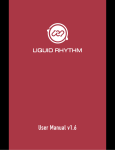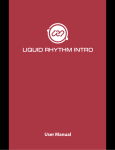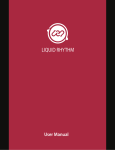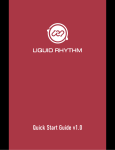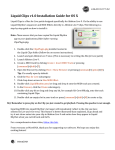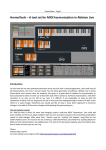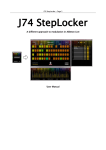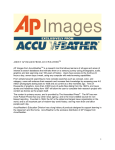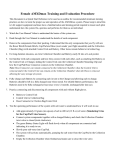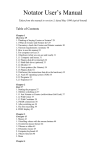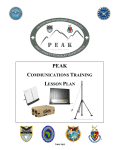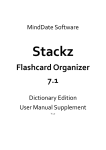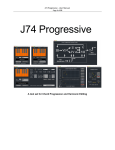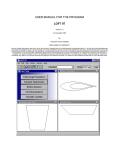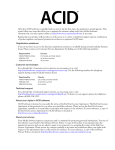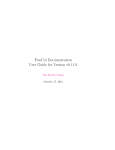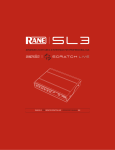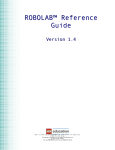Download LIQUID RHYTHM
Transcript
LIQUID RHYTHM User Manual Liquid Rhythm User Manual v1.8 December 2013 Liquid Rhythm User Manual written by Haig Beylerian Allison Janzen Glen Kappel Saro Migirdicyan Aris Plampe Legal Notices This product is subject to the terms and conditions of a software license agreement. This user manual is copyrighted © 2013 by WaveDNA Inc., (hereafter “WaveDNA”), with all rights reserved. Under copyright laws, this user manual may not be duplicated in whole or in part without the written consent of WaveDNA. Product features, specifications, system requirements and availability are subject to change without notice. Document Feedback We are constantly looking for ways to improve our documentation. If you have any comments, corrections or suggestions regarding our documentation, please email us at [email protected] Table of Contents Table of Contents ............................................................................................................................................. 2 Chapter 1: Welcome to Liquid Rhythm .................................................................................................... 6 System requirements & Installation .......................................................................................................................................... 6 OS X Installation Guide ..................................................................................................................................................................... 6 Liquid Rhythm -‐ Windows Installation Guide ......................................................................................................................... 7 The Basics .............................................................................................................................................................................................. 8 OS X & Windows Keyboard Commands Terminology ......................................................................................................... 8 Mouse Terminology ............................................................................................................................................................................ 8 Welcome Screen .................................................................................................................................................................................. 9 Setting up Audio and MIDI Preferences ................................................................................................................................ 10 Selecting an Audio Interface ....................................................................................................................................................... 10 Setting a Buffer Size ........................................................................................................................................................................ 10 Connecting a MIDI Device ............................................................................................................................................................ 10 Testing Your External MIDI Controller .................................................................................................................................. 11 Look and Feel .................................................................................................................................................................................... 11 Chapter 2: Digital audio workstation integration ............................................................................. 12 OS X ........................................................................................................................................................................................................ 12 Logic Pro 9 .......................................................................................................................................................................................... 12 Ableton Live 9 .................................................................................................................................................................................... 12 Ableton Live 8 .................................................................................................................................................................................... 13 Pro Tools HD 10 ................................................................................................................................................................................ 13 Presonus Studio One 2 .................................................................................................................................................................... 13 Windows ............................................................................................................................................................................................. 14 Ableton Live 9 .................................................................................................................................................................................... 14 Liquid Clips v1.0 Installation Guide for OS X ....................................................................................................................... 15 Liquid Clips v1.0 Installation Guide for Windows ............................................................................................................. 16 Chapter 3: Project, Arranger, and Transport, Controls ................................................................... 17 Project File Commands ................................................................................................................................................................. 17 New Project ......................................................................................................................................................................................... 17 Open Project ....................................................................................................................................................................................... 17 Open Recent ........................................................................................................................................................................................ 17 Save ........................................................................................................................................................................................................ 17 Save As .................................................................................................................................................................................................. 17 Consolidated Save ............................................................................................................................................................................ 17 2 Import MIDI File ............................................................................................................................................................................... 18 Export to MIDI File .......................................................................................................................................................................... 18 Export to Audio File ........................................................................................................................................................................ 18 The Arranger Canvas ..................................................................................................................................................................... 19 Create a Track ................................................................................................................................................................................... 19 Track Headers ................................................................................................................................................................................... 19 Track Header Commands ............................................................................................................................................................ 22 Duplicate .............................................................................................................................................................................................. 22 Duplicate Track and Contents .................................................................................................................................................... 22 Delete a Track(s) .............................................................................................................................................................................. 22 Select/Deselect All Tracks ............................................................................................................................................................ 22 Note Edit Mode ................................................................................................................................................................................. 23 Note Edit Grid Snap Mode .......................................................................................................................................................... 23 Zooming In and Out ........................................................................................................................................................................ 24 Zooming manually ........................................................................................................................................................................... 24 Transport Bar .................................................................................................................................................................................... 25 Tempo & Metronome ...................................................................................................................................................................... 25 Rewind to Start ................................................................................................................................................................................. 25 Back One Bar/Forward One Bar ............................................................................................................................................... 25 Play/Stop ............................................................................................................................................................................................. 25 Recording ............................................................................................................................................................................................. 26 Playhead Position ............................................................................................................................................................................. 26 Follow .................................................................................................................................................................................................... 26 Loop Mode & Defining a Loop Region ..................................................................................................................................... 27 Lock Loop to Focus .......................................................................................................................................................................... 27 Note & Velocity .................................................................................................................................................................................. 28 Computer MIDI Keyboard Mode ................................................................................................................................................ 28 Beat Builder and BeatWeaver Panels ..................................................................................................................................... 28 Library Mixer, & Molecule Tools Panel Buttons ................................................................................................................. 28 Chapter 4: Molecule Tools ......................................................................................................................... 29 Randomizer ........................................................................................................................................................................................ 29 Random BarForm ............................................................................................................................................................................ 29 Random BeatForm .......................................................................................................................................................................... 29 GrooveMover ..................................................................................................................................................................................... 30 Accent Modifiers .............................................................................................................................................................................. 31 Strong, Medium, and Weak .......................................................................................................................................................... 31 Chapter 5: The Library & Mixer Panels ................................................................................................. 35 3 The Library ......................................................................................................................................................................................... 35 Instruments, Kits, and Loops Library Tabs ........................................................................................................................... 35 Audition Tools .................................................................................................................................................................................... 36 Instrument Editor ........................................................................................................................................................................... 37 Loading a Sample ............................................................................................................................................................................. 37 Loading Multiple Samples Simultaneously ........................................................................................................................... 37 Velocity Map ....................................................................................................................................................................................... 37 Auditioning Samples ....................................................................................................................................................................... 38 Instrument Audition Bar ............................................................................................................................................................... 38 Adjusting Articulation Boundaries ........................................................................................................................................... 39 Assigning a MIDI Note to a Instrument .................................................................................................................................. 40 Saving an Instrument ..................................................................................................................................................................... 40 The Mixer ............................................................................................................................................................................................ 41 Track Title ........................................................................................................................................................................................... 41 MIDI From ........................................................................................................................................................................................... 41 MIDI To ................................................................................................................................................................................................. 41 Audio To ............................................................................................................................................................................................... 42 Instrument Selector & Instrument Swap ............................................................................................................................... 42 Volume Fader, Balance Knob, Solo, Mute, & Record ......................................................................................................... 42 Chapter 6: The Beat Builder ...................................................................................................................... 43 BarForm List ...................................................................................................................................................................................... 44 BarForm Filters ................................................................................................................................................................................. 44 Beat Build Quick Insert .................................................................................................................................................................. 45 BeatForm Sequencer ...................................................................................................................................................................... 46 Sequencer ............................................................................................................................................................................................ 46 Remixer ................................................................................................................................................................................................. 48 Chapter 7: The BeatWeaver Rhythm Synthesizer ............................................................................. 49 The BarForm & BeatForm Maps ............................................................................................................................................... 49 BarForm Map ..................................................................................................................................................................................... 49 Zooming Into the BarForm Map ................................................................................................................................................ 50 BeatForm Map ................................................................................................................................................................................... 50 Deployment Bins ............................................................................................................................................................................... 51 BeatForm Sequence List ................................................................................................................................................................ 52 BeatForm Sequence List Tools ................................................................................................................................................... 53 Chapter 7 Help and Troubleshooting .................................................................................................... 54 On-‐Screen Help .................................................................................................................................................................................. 54 Troubleshooting ............................................................................................................................................................................... 54 4 Known Software Incompatibility .............................................................................................................................................. 54 Index ................................................................................................................................................................. 55 5 Chapter 1: Welcome to Liquid Rhythm On behalf of everyone at WaveDNA, thank you for your interest in our software. This document will help you get the software up and running, guide you through your first steps, and provide a comprehensive overview of every available feature. System requirements & Installation Mac: Intel dual-‐core processor, 2 GB RAM (recommended 4 GB), 6 GB hard disk space, OS X 10.6 or later, Java v. 1.6 or later PC: 2 GB RAM (recommended 4 GB), 6 GB hard disk space, Windows XP/Vista/Windows 7, Java v. 1.6 or later, ASIO-‐compatible sound card recommended OS X Installation Guide 1. Double-‐click the LiquidRhythm.dmg file to mount it. 2. Drag the Liquid Rhythm icon into the Applications folder to install the application. 3. Double-‐click InstallPlugins.pkg to install VST, RTAS, and/or AU plugins. 4. Congratulations, you’re done. Launch Liquid Rhythm standalone or as a plugin in choice of DAW software. 6 Liquid Rhythm -‐ Windows Installation Guide 1. Double-‐click the installer file LiquidRhythm.exe to launch the setup wizard. 2. Follow the steps in the setup wizard. 3. Select a destination folder. C:\Program Files (x86)\WaveDNA\Liquid Rhythm is the default destination. 4. Review your shortcut options. 5. Click Install to complete the installation process. 6. In order for Liquid Rhythm to run, Microsoft Visual C++ Redistributable must also be installed. It’s a small package required to run software written using the C++ language. To learn more about it, visit: http://www.microsoft.com/en-‐ ca/download/details.aspx?id=5555 7. The Liquid Rhythm installer automatically installs Liquid Clips, a Max for Live patch for Ableton Live 9. If you don’t have Max 6.1 and Ableton Live 9 installed, you will get a message notifying you that Liquid Clips plugin was not installed. You’ll be missing out on this feature but don’t worry: Your install will still complete successfully. Click Ok. 8. Click Finish to close the install window and complete the install. Note: For more information on Liquid Clips, visit the Liquid Clips Best Practices page. 7 The Basics The purpose of this guide is to show you every available feature within Liquid Rhythm to have you using it with ease and to the fullest. OS X & Windows Keyboard Commands Terminology Throughout this User Manual, keyboard shortcuts will be presented using a combination of modifier keys and keyboard keys. Note that Apple and Windows keyboards have different names for modifier keys that serve the same function in Liquid Rhythm. For your reference and convenience, modifier keys will always be presented in the order of [OS X]/[Win] where OS X refers to Apple keyboards and Win refers to Windows keyboards. Modifier Keys are: ∗ [command]/[ctrl] ∗ [option]/[alt] ∗ [shift] Mouse Terminology ∗ Click: to hover the mouse arrow over an object, menu item, etc., and single-‐click with the left mouse button. ∗ Double-‐click: to hover the mouse arrow over an object, menu item, etc., and double-‐click with the left mouse button. ∗ Right-‐Click: to hover the mouse arrow over an object and single-‐click with the right mouse button. Tip: Right-‐clicks typically open pop-‐up or pull-‐down menus for that specific clickable object. ∗ Drag: to click on an object and hold down the mouse button while moving the mouse. To stop the drag from occurring, release the mouse button. 8 Welcome Screen A Welcome Screen greets you when you launch Liquid Rhythm. The following is a brief description of the helpful features found there: Quick Tutorial loads a demo loop ∗ Help slides in the bottom left pane guide you through using the BeatWeaver and highlight the relationship between the bars in the arranger and in the BarForm Map. Watch Tutorial Video ∗ Launches Liquid Rhythm’s “Videos” page in your web browser. Start Walkthrough ∗ A comprehensive and interactive walkthrough of some of the features found in Liquid Rhythm. New Project ∗ Opens a new, blank project. Open Project ∗ Opens a previously saved project file. Show On Startup ∗ Deselect this option to prevent the Welcome Screen from opening each time you launch Liquid Rhythm. Close ∗ Closes the Welcome Screen window. 9 Setting up Audio and MIDI Preferences When you launch Liquid Rhythm for the first time, default driver and audio input/output settings will be loaded. Click on Options > Settings or use the [command]/[ctrl]+[,] key command to access the Settings menu and configure audio preferences. Selecting an Audio Interface In the Settings window under the Audio tab, click the Driver drop-‐down menu and select the driver/audio interface of your choice. To ensure playback, set the Audio drop down menu to On. Tip: In the event that your audio interface or MIDI device doesn’t appear, it may be possible you haven’t set up your device’s drivers yet. Consult the manufacturer’s website for details on installing drivers. Setting a Buffer Size Latency and crackling audio are common issues with DAW software. Adjusting the buffer size addresses both these issues. You can select the appropriate buffer size by clicking the I/O Vector Size drop-‐down menu and setting the value to your desired amount. If you need more help, check out the Troubleshooting section. Tip: CPU overload errors are typically avoided with a higher buffer size. Recording latency issues are avoided with a smaller buffer size. Connecting a MIDI Device There are two ways to connect a MIDI device to your computer: 1. Connecting an external MIDI device directly via usb: • Many new MIDI devices connect to your computer with a usb cable and have their own drivers. Make sure your MIDI device is connected to your computer and recognized by your operating system before launching Liquid Rhythm. 2. Connecting an external MIDI device through a MIDI interface: • Once you’ve connected your MIDI interface, make the following physical connections between your external MIDI device and MIDI interface: ◊ The MIDI Out on your external device is connected to the MIDI IN on your MIDI interface. 10 ◊ The MIDI IN on your external device is connected to the MIDI OUT on your MIDI interface. Tip: To ensure you have followed all the necessary steps and installed all the necessary drivers to enable compatibility between your computer and MIDI interface, please reference the MIDI interface manufacturer’s documentation or website. Testing Your External MIDI Controller The MIDI Note and Vel indicators to the right of the toolbar will display MIDI values Liquid Rhythm receives from an external device. With your MIDI device connected and turned on, press a key on your MIDI keyboard, drum pad or control surface to test connectivity and monitor it using the indicators. Look and Feel Adjusting the visual appearance and behavior of various user interface elements in Liquid Rhythm is easily accessible in the Look and Feel tab found in the Settings window. To access the Settings window, click Options > Settings or use the [command]/[ctrl]+[,] key command. Try playing with these settings to see which configuration works best for you or use our Low Quality Presets and High Quality Presets buttons to quickly swap between contrasting visual experiences. 11 Chapter 2: Digital audio workstation integration OS X The Liquid Rhythm VST, AU, and RTAS plugins allow you to use Liquid Rhythm within your preferred digital audio workstation (DAW) in OS X. For your convenience, step-‐by-‐step plugin loading procedures have been prepared for all tested DAW’s. Tip: Please note that there are always multiple ways to achieve the same goal when using a DAW. The following steps describe one way of loading a plugin; other ways exist, and we encourage you to explore them. Also, keep in mind that these instructions don’t include creating a project. For more information on how to create a project using your host DAW software, please consult their help documentation. The following is a list of all tested software and the plugin loading procedures for each: Logic Pro 9 1. Create a Software Instrument track by either clicking Track > New… or press [command]+[option]+[N]. 2. Note the corresponding channel strip for the track you just created in the pane to the left of the arrange page. Above the volume fader, there are two buttons beneath the label I/O. Click and hold the first of the two buttons to reveal a dropdown list with all the available plugins in your plugin library. 3. Scroll to the bottom of the list by hovering over the arrow and release the left mouse button on AU Instruments > WaveDNA > LiquidRhythm > Stereo. Tip: You can select any output configuration (stereo, 8x stereo, and so on) to suit your needs. Ableton Live 9 1. Create a MIDI track by clicking Create > Insert MIDI Track or pressing [command]+[shift]+[T]. 2. Click View > Show Browser or press [command]+[option]+[B] to view the contents of the Browser (the pane on the left of the screen). 12 3. Under Categories, click Plugins. 4. Navigate to either Audio Units > WaveDNA > LiquidRhythm or VST > LiquidRhythm and drag and drop the plugin onto the MIDI track you just created to launch Liquid Rhythm. Ableton Live 8 1. Navigate to your installed plugins by clicking View > Browser > Plug-‐In Devices. 2. Ableton Live 8 is compatible with both VST and AU plugins. Navigate to either Audio Units > WaveDNA > LiquidRhythm or VST > Local > LiquidRhythm. 3. Double-‐click LiquidRhythm plugin onto the MIDI track you just created. Tip: If you want to swap LiquidRhythm plugin for a plugin you have already loaded in a MIDI track, select the MIDI track and double-‐click LiquidRhythm in the Plug-‐In Devices browser. Pro Tools HD 10 1. Create a new track by either clicking on Track > New… or press [command]+[shift]+[N]. 2. In the dialogue box that appears, adjust the options for your new track from Mono to Stereo and change the type of track from Audio Track to Instrument Track. 3. Click the Create button. 4. Launch the Mix window by either clicking Window > Mix or using the [Command]+[=] key command. 5. Locate the Instrument track you just created; it will most likely be labeled Inst 1. At the very top of the track, you will find the Inserts A-‐E panel. Click the first empty space to reveal the dropdown menu and click on multichannel plug-‐in > Instrument > LiquidRhythm (Stereo) to launch Liquid Rhythm RTAS plugin. Presonus Studio One 2 1. Click View > Show Instruments 2. Click WaveDNA in the Instruments pane on the left to reveal the plugins 3. Drag and drop either the VST or AU Liquid Rhythm plugin onto the blank arranger to create an instrument track and launch Liquid Rhythm 13 Windows The Liquid Rhythm VST plugin allow you to use Liquid Rhythm within your preferred digital audio workstation (DAW) in Windows. For your convenience, step-‐by-‐step plugin loading procedures have been prepared for all tested DAW’s. Tip: Please note that there are always multiple ways to achieve the same goal when using a DAW. The following steps describe one way of loading a plugin; other ways exist, and we encourage you to explore them. Also, keep in mind that these instructions don’t include creating a project. For more information on how to create a project using your host DAW software, please consult their help documentation. The following is a list of all tested software and the plugin loading procedures for each: Ableton Live 9 1. Create a MIDI track by clicking Create > Insert MIDI Track or pressing [ctrl]+[shift]+[T]. 2. Click View > Show Browser or press [ctrl]+[alt]+[B] to view the contents of the Browser (the pane on the left of the screen). 3. Under Categories, click Plugins. 4. Navigate to the LiquidRhythm plugin and double-‐click it or drag and drop it onto the MIDI track you just created to launch Liquid Rhythm. 14 Liquid Clips v1.0 Installation Guide for OS X Liquid Clips is a Max for Live patch designed specifically for Ableton Live 9. It’s the ability to use Liquid Rhythm’s sequencer and MIDI Effects directly in Ableton Live 9 clips. The following is a step-‐by-‐step guide on how to install it: Note: Please ensure that you have copied the Liquid Rhythm app to your Applications folder before running ClipsPlugin.pkg. 1. Double-‐click the ClipsPlugin.pkg installer located in the Liquid Clips folder (follow the on-‐screen instructions). 2. Launch and quit Ableton Live 9 once. (This is necessary to writing the Max for Live patch) 3. Launch Ableton Live 9. 4. Create a MIDI track by clicking Create > Insert MIDI Track or pressing [command]+[shift]+[T]. 5. Open the Browser by clicking View > Show Browser or pressing [command]+[option]+[B]. Tip: It’s usually open by default. 6. Click the Max for Live subcategory. 7. Click drop-‐down arrow in Max MIDI Effect. 8. Double-‐click LiquidRhythm.amxd or drag and drop it onto the MIDI track you created. 9. In the Browser, click the Drums subcategory. 10. Double-‐click or drag and drop any kit, for example Kit-‐Core 808.adg, onto the track containing Liquid Clips. 11. Double-‐click an empty slot in your track or press [command]+[shift]+[M] to create a clip. Hey! Remember to press play on the Clip you just created to get playback. Inputting MIDI into Liquid Rhythm’s Arranger will immediately reflect in the clip you have selected in Live and vice versa. This feature is better illustrated than explained, so go ahead and try it out: draw notes into your clip in Ableton Live 9 and notice how they appear in Liquid Rhythm when you switch back and forth. For a comprehensive look, make sure you visit the Liquid Clips Best Practices page! From everyone at WaveDNA, thank you for supporting our software. We hope you enjoy this exciting feature! 15 Liquid Clips v1.0 Installation Guide for Windows Liquid Clips is a Max for Live patch designed specifically for Ableton Live 9. It’s the ability to use Liquid Rhythm’s sequencer and MIDI Effects directly in Ableton Live 9 clips. The following is a step-‐by-‐step guide on how to install it: Note: Presently, Liquid Clips is only supported on the 32-‐bit version of Ableton Live 9. 1. Navigate to your downloads folder and double-‐click LiquidRhythm.exe. 2. Follow the steps in the installation wizard, including selecting the destination folder and configuring shortcuts. 3. When the installer is done, click Finish. 4. Launch and quit Ableton Live 9 once. (This is necessary to writing the Max for Live patch) 5. Launch Ableton Live 9. 6. Create a MIDI track by clicking Create > Insert MIDI Track or pressing [ctrl]+[shift]+[T]. 7. Open the Browser by clicking View > Show Browser or pressing [ctrl]+[option]+[B]. Tip: It’s usually open by default. 8. Click the Max for Live subcategory. 9. Click drop-‐down arrow in Max MIDI Effect. 10. Double-‐click LiquidRhythm.amxd or drag and drop it onto the MIDI track you created. 11. In the Browser, click the Drums subcategory. 12. Double-‐click or drag and drop any kit, for example Kit-‐Core 808.adg, onto the track containing Liquid Clips. 13. Double-‐click an empty slot in your track or press [command]+[shift]+[M] to create a clip. Hey! Remember to press play on the Clip you just created to get playback. Inputting MIDI into Liquid Rhythm’s Arranger will immediately reflect in the clip you have selected in Live and vice versa. This feature is better illustrated than explained, so go ahead and try it out: draw notes into your clip in Ableton Live 9 and notice how they appear in Liquid Rhythm when you switch back and forth. For a comprehensive look, make sure you visit the Liquid Clips Best Practices page! From everyone at WaveDNA, thank you for supporting our software. We hope you enjoy this exciting feature! 16 Chapter 3: Project, Arranger, and Transport, Controls Project File Commands New Project To create a new project, click File > New or press [command]/[ctrl]+[N] Open Project To open an existing project, click File > Open or press [command]/[ctrl]+[O] to launch the Open dialog box, navigate to your project file and either: ∗ Double-‐click the file and click Open. ∗ Select the file and click it. Open Recent Hover your mouse over File > Open Recent to view a drop-‐down menu containing your most recent Liquid Rhythm projects. Click an entry to load it. Save To save a new or existing project file, click File > Save or press [command]/[ctrl]+[S] to launch the Save dialog box. Enter a name for your project and specify a location on your hard drive to save it. Click Save to confirm. Save As To save a new version of an existing project file, click File > Save As or press [command]/[ctrl]+[shift]+[S] to launch the Save As dialog box. Enter a name for your project and specify a location on your hard drive to save it. Click Save to confirm. Consolidated Save To save a project file with Instrument Editor assets, including external audio samples, click File > Consolidated Save. 17 Import MIDI File To import an existing MIDI file, do the following: 1. Click File > Import MIDI File 2. Navigate to the MIDI file you want to import. 3. Choose a General MIDI Kit to load with the file. 4. Click Open to import the MIDI file. Tip: For optimized use with a percussive MIDI performance, ensure that Only General MIDI Percussion Note Numbers and Only Notes in MIDI Percussion Channel (10) are selected. Export to MIDI File To export your project as a MIDI file, do the following: 1. Click File > Export to MIDI File 2. Name the MIDI file in the File Name dialog box. 3. Click Save to export to MIDI. Note that all the drum and percussion tracks in your Liquid Rhythm file are automatically mapped using the General MIDI standard. Export to Audio File With Liquid Rhythm standalone, you can export your project as a WAV or AIFF audio file. To do so: 1. Define the Start and End points of your audio file using the Loop Region. 2. Click File > Export to Audio File to open the Export Audio window. 3. Enter a name for your audio file in the Save As dialog box. 4. Select a destination to save your file. 5. Choose either WAV or AIFF from the File Type drop-‐down menu. 6. Choose the bit depth from the Bit Depth drop-‐down menu. 7. Select: a. Master Mix to render every track in your project file to audio. b. Individual Tracks to select specific tracks from the window to the left 8. Click Export to start rendering to audio. 18 The Arranger Canvas Liquid Rhythm’s arranger is a digital canvas; what you create with it is entirely up to you. The grid is designed to help you organize your ideas as you create them: the lines running vertically through the grid represent divisions in time, while the lines running horizontally separate each track. The Playhead (the thin vertical line that moves when you press Play) indicates the current frame during playback and zoom processes. The following section will walk you through the elements of the arranger. Create a Track To create an empty track, perform any of the following actions: ∗ Right-‐click anywhere in the arranger grid and select create track from the drop-‐down menu ∗ Click Insert > Create Track ∗ Press [command]/[ctrl]+[T] ∗ Double-‐click an instrument in the library To add or swap voices into the newly created track, simply drag-‐and-‐drop Instruments from the Library onto the Channel Header. Track Headers Each track you create in Liquid Rhythm has a corresponding track header in the arranger canvas and a channel strip in the Mixer panel. The following is a detailed description of the features found on a track header: 19 1. Track Name ∗ Displays the name of the instrument currently loaded into the track. To rename the track, click on the track name and type a new name. To manually select a different instrument, click the dropdown menu and choose an instrument from the list. 2. Instrument Swap Button ∗ Click the Instrument Swap Button to swap any sound in the Library for the one you have presently loaded. The track name updates to reflect the new instrument loaded. How to use it: 1. First, open the Library by pressing [command]/[ctrl]+[1] 2. Activate Swap Mode for the track whose Instrument you want to swap. 3. Single-‐click any instrument in the Library and it will swap into the track. Note that activating Swap Mode on a track causes the Library to filter instruments specific to that track. Swapping is a great way to audition instruments during playback! Tip: Another way to quickly swap instruments is to drag-‐and-‐drop them from the Library onto the Channel Header. 3. Color Bar ∗ Located at the right of the track header, it denotes what instrument type the instrument is. To pick another color, right-‐click on the Channel Header and select Change Track Color from the dropdown menu. Select a color using any of the three tabs and click Ok to confirm your selection. ∗ Click the Color Bar to fold the track. 4. Volume Fader ∗ Controls the track’s volume. Click the volume fader and move the mouse left or right to set the volume for your track. Command-‐click to return the fader to its default value. 20 5. Solo ∗ Click the button labeled S to isolate the track(s) you want to hear without the rest of the project playing. 6. Mute ∗ Click the button labeled M to mute the track(s) you do not want to hear. 7. Record: ∗ Click the button labeled R to write any MIDI input received from the computer or external device to the selected track(s). Tip: Press and hold [shift] while clicking any Mute or Record button to affect every channel. 8. MIDI Input Note Number ∗ Indicates the MIDI note value associated with the track. Click the value and drag the mouse up or down to map the instrument to another MIDI note. 9. MIDI Activity Light: ∗ Click this button to audition the instrument loaded in the track. 10. Balance Knob ∗ Varies the relative level of the left and right channels in the track. Click on the knob and drag the mouse up and down to change its value; command-‐click to return the knob to its default value. 21 Track Header Commands Duplicate To make a duplicate of a track, right-‐click the Track Header(s) and select Duplicate. Duplicate Track and Contents To make a copy of a track and its regions, right-‐click the Track Header(s) and select Duplicate Track and Contents or press [command]/[ctrl]+[D]. Delete a Track(s) To delete a track, right-‐click the Track Header(s) and select Delete or press the [delete]/[backspace] or [delete] button on the keyboard. Select/Deselect All Tracks To select all the tracks, right-‐click the Track Header and select Select All Tracks or press [command]/[ctrl]+[A]. To deselect all the tracks, right-‐click a Track Header and select Deselect All Tracks or press [command]/[ctrl]+[shift]+[A]. 22 Note Edit Mode Use Note Edit Mode to draw MIDI notes directly onto the arranger canvas with your mouse. Enable it by performing any of the following actions: ∗ Click the pencil tool ∗ Press [command]/[ctrl]+[E] ∗ Right-‐click anywhere in the arranger and select Note Edit Mode from the dropdown menu. Note Edit Grid Snap Mode Enable Note Edit Grid Snap Mode to force the notes you enter using Note Edit Mode to quantize to the grid. By default, this feature is on. To toggle it on or off, press the Note Edit Grid Snap Mode button above the track headers. To set the Note Edit Grid Resolution, select the desired value from the drop-‐down menu directly to the right of the snap to grid button. Note that you can toggle the Triplet grid. 23 Zooming In and Out There are a variety of ways to zoom in and out of the arranger canvas. ∗ Zoom to Selection: select a region(s) and click View > Zoom to Selection or press [command]/[ctrl]+[R] to get a close-‐up view. ∗ Zoom Out to Maximum: click View > Zoom Out to Maximum or press [shift]+[command]/[ctrl]+[R] to get a view of the entire project. ∗ Zoom to Default: click View > Zoom to Default or press [command]/[ctrl]+[B] to return the arranger canvas to the default view. ∗ Zoom In To Focus: select a region(s) and click View > Zoom In to Focus or press [command]/[ctrl]+[=] to incrementally zoom in. ∗ Zoom Out from Focus: select a region and click View > Zoom Out from Focus or press [command]/[ctrl]+[-‐] to incrementally zoom out. Zooming manually Use the 1. Overview Scroll and Zoom bar, the 2. Zoom Vertical Slider, and the 3. Ruler Bar to manually adjust the arranger canvas view with simple click and drag gestures using your mouse. 24 Transport Bar Playback, tempo, loop region controls, quick controls, and the show/hide buttons for all the panels can be found in the Transport Bar. Note: Playback and tempo will be synced to your host DAW’s transport in plug-‐in mode and disabled in Liquid Rhythm. 1. Tempo & Metronome Click the Metronome button to activate Liquid Rhythm’s click track in standalone mode. The tempo window displays the current project’s beats per minute (BPM). Adjust the tempo by performing any of the following actions: ∗ Click the Tempo window and drag the mouse up or down to increase or decrease the tempo value. ∗ Click the Tempo window and enter a numerical value using your keyboard. ∗ Click the Tempo window and press the up and down cursors on the keyboard to increase or decrease the tempo. Tip: Note that in plug-‐in mode, tempo controls in Liquid Rhythm are disabled 2. Rewind to Start ∗ Rewind to the beginning of the arrangement. 3. Back One Bar/Forward One Bar ∗ Moves the Playhead back or forward by one bar. 4. Play/Stop Use these buttons to start and stop playback. Alternatively, press the [spacebar] to both play and stop. Tip: Press Play during playback to Pause the track. 25 5. Recording To record a beat to Liquid Rhythm’s arranger canvas: 1. Turn Record Mode on by clicking the Record Mode button on the transport panel. 2. Arm a track(s) by pressing the R button on the track header. Tip: You can arm every track in the arranger by pressing [shift] and clicking the Record button within the track header. 3. Press the Play button in the transport panel or the [spacebar] to start recording. 6. Playhead Position The Playhead is the thin vertical line that scrolls to indicate what regions and notes are being read during playback. The Playhead Position window displays where the Playhead is using a three-‐digit numerical value denoting bars.quarters.sixteenths. For example, 2.3.1 means that the Playhead is at the 1st sixteenth note of the 3rd quarter note of the 2nd bar. To manually adjust the location of the Playhead, either: ∗ Click on the first value (bar) in the Playhead Position window, enter a number using the numbers on your keyboard, and press [return]/[enter]. ∗ Click on the first value in the Playhead Position window and drag the mouse up or down to increase or decrease the value. 7. Follow Press the Follow button or use the [command]/[ctrl]+[F] key command to scroll through the arranger canvas during playback. When Follow is disabled, the view on the Arrange Page will stay in the same position when the Playhead goes out of view. You can adjust the behavior of the Follow feature. To do so: 1. Click Options > Settings or press [command]/[ctrl]+[,] to open the Settings menu. 2. Click the Look and Feel tab at the top of the Settings window. 3. Click the Playhead Follow Behavior dropdown menu to select from either Scroll or Page. 26 8. Loop Mode & Defining a Loop Region Loop mode enables you to loop a specific section of your beat. Enable Loop Mode by performing any of the following actions: ∗ Click the Loop Toggle button. ∗ Select a region(s) and press [command]/[ctrl]+[L] to activate Loop Mode and redefine the loop region to match your selection. There are two ways to define the Loop Region: ∗ Using the Loop Region bar, o Resize by clicking the edge(s) of the Loop Region bar and dragging the mouse left or right to extend the region. o Reposition by clicking the center of the Loop Region bar and dragging the mouse left or right. ∗ Using the Loop Length and Loop Start windows, o Resize by clicking the Loop Length window and either dragging the mouse up or down or manually entering a value using the numbers on your keyboard and pressing [return]/[enter] to confirm. o Reposition by clicking the Loop Start window and either dragging the mouse up or down or manually entering a value using the numbers on your keyboard and pressing [return]/[enter] to confirm. 9. Lock Loop to Focus Once you’ve defined a loop region, click the Lock Loop to Focus button to automatically loop the bar presently selected. 27 10. Note & Velocity Show the MIDI note being played on an external MIDI control device and its velocity (from 0-‐27). 11. Computer MIDI Keyboard Mode Enable Computer MIDI Keyboard Mode to use your computer keyboard as a MIDI drum pad with the instruments laid out in a 4x4 grid and mapped according to the General MIDI Standard. Use the image to the right to identify what MIDI note number each key triggers. 12. Beat Builder and BeatWeaver Panels Use these buttons to show and hide either the Beat Builder or BeatWeaver panels. Alternatively, use the following keyboard shortcuts: ∗ Beat Builder: [command]/[ctrl]+[1] ∗ BeatWeaver: [command]/[ctrl]+[2] ∗ BeatWeaver with BeatForm Map displayed: [command]/[ctrl]+[6] ∗ BeatWeaver with BarForm Map displayed: [command]/[ctrl]+[7] 13. Library Mixer, & Molecule Tools Panel Buttons Use these buttons to show and hide the Library, Mixer, and Molecule Tools panels. Alternatively, use the following keyboard shortcuts: ∗ Library: [command]/[ctrl]+[3] ∗ Molecule Tools: [command]/[ctrl]+[4] ∗ Mixer: [command]/[ctrl]+[5] 28 Chapter 4: Molecule Tools The Molecule Tools are a suite of MIDI effects that add variety, character, and excitement to the beats you create using Liquid Rhythm. From unexpected to completely informed musically, the results you get with these effects are totally up to you. Randomizer The Randomizer is a MIDI effect containing four customizable parameters that target the selected region(s) in the arranger. The four sliders can be activated or deactivated. Random BarForm Activate Random BarForm to populate the selected region(s) in the Arranger with a BarForm from the BarForm List in the Beat Builder. Random BeatForm Activate Random BeatForm to populate the selected region(s) in the Arranger with a BeatForm(s) from the BeatForm Sequencer. 29 GrooveMover The GrooveMover rearranges the beats in your bar, giving you instant variations or remixes of your note patterns. To use it, click the up and down arrow buttons, or the colored pattern buttons Tip: Try selecting every region in a four bar loop and applying GrooveMover. To Move Notes, or not to Move Notes? Liquid Rhythm suggests underlying rhythmic salience patterns based on the notes in a bar. Deselect Move Notes to override Liquid Rhythm’s suggestions without shifting the notes around. Simply click on a BarForm pattern (any colored rectangle) to swap it into the selected region(s). Tip: Notice how the Accent Modifiers shift as you change underlying BarForm patterns. Try different patterns to use the Accent Modifiers on and to get a wider variety of results from the GrooveMover. 30 Accent Modifiers Use the Accent Modifiers to quickly and easily alter the velocity and/or groove of a selected region(s). To access the Molecule Tools panel, either: ∗ Click the MT button to the far right of the toolbar. ∗ Press [command]/[ctrl]+[4] Strong, Medium, and Weak Each 8th note beat in a 4/4 bar has unique rhythmic significance. This musical phenomenon is visualized in Liquid Rhythm using dark, medium, and light tones of red as Blue blocks represent note groupings of two S tr on We ak Me d iu m and blue; these three tones are referred to g strong, medium, and weak. and red blocks represent groupings of three. Accent Modifier target buttons Accent modifiers target the velocity and groove of a note(s) based on their positions within a beat or an entire bar. To toggle focus between the notes in a bar and the notes in a beat, click the Accent Modifiers Target buttons. BeatForm targets all the notes grouped by the smaller step sequencer. BarForm targets all the notes grouped by the larger step sequencer. 31 Velocity Sliders Velocity Sliders target the velocity, or volume, as well as timbre of a sound(s) based on their position within the Click the slider whole bar or single beat. and drag up or down using your mouse to increase or decrease velocity. Humanize the velocity of your beat by dragging the handles above and below the sliders. Random velocity values within the slider’s range will be applied to the selection. Velocity Sliders in Action All the notes in the strong positions have a low velocity. Hovering over a slider highlights the affected Notice that the Notes notes. In this case, all the in the Bar are being notes occurring on the weak beats are lit up. targeted. 32 Groove Sliders Groove Sliders target the groove, or offset of time, of notes or groups of notes based on their position within a bar or beat. Click the slider and drag left or right to move the notes earlier or later in time. Humanize the groove of your beat by dragging the handles to the left and right of the sliders. Note that random groove values within the sliders’ range will be generated Groove Sliders in Action Hovering over a slider highlights the affected notes. In this case, all the notes occurring on the Strong beats are lit up Notice that the Notes in the Beat are being targeted. 33 Learn the velocity and When enabled, Auto adjusts groove values from the velocity and groove settings to currently selected region(s) reflect the selected region(s) in in the Arranger. the Arranger. Apply the velocity and Reset the velocity and groove values of the groove values of the current sliders to all selected region(s) in the selected regions in the Arranger to defaults. Arranger. 34 Chapter 5: The Library & Mixer Panels The Library Liquid Rhythm features a resource library with a wide variety of acoustic and electronic drum, percussion, and pitched percussion samples. Specify which version(s) of the library you want to download in the popup window located at Help > Download Complete Library. If, for any reason, your internet connectivity is lost during the library download, Liquid Rhythm will automatically resume the download on application restart. Instruments, Kits, and Loops Library Tabs Instruments The Instruments tab consists of acoustic, electronic, percussive, and pitched Instruments comprised of 1-‐10 samples, each responding to various velocity ranges—this allows for realistic dynamics and expression when performing or programming a beat. For a dramatic and instant demo of how this sounds, use the Accent Modifiers. Scroll up or down to navigate through the entire list or use the buttons below the tabs to narrow your selection options to a specific instrument grouping. Alternatively, search for Instruments by typing the desired name into the search field directly below the instrument type buttons. To load an instrument, simply double-‐click it. Kits The Kits panel consists of pre-‐grouped instruments that can be loaded simultaneously. To load a kit, double-‐click it. Use the kits panel to get started quickly and easily. 35 Loops The Loops panel consists of kits and drum loops stored in Liquid Rhythm’s library. Click the buttons below the Library tabs to narrow your selection options by genre. For example, click the Dubstep button to limit your selections to dubstep beats. Alternative, use the search field below the genre buttons to type in a genre. To load a loop, double-‐click it. Audition Tools All the instruments in Liquid Rhythm’s library can be auditioned before loading them. To do so, click any Instrument. To control the audition volume for an instrument, kit, or loop, click the audition volume fader and drag your mouse left or right to decrease or increase the volume. Stop Audition Playback To stop the playback of a instrument, kit, or loop, click the stop button, indicated by the small square on the bottom right of the library panel. Auto-‐Audition Mode Auto-‐audition makes it possible for you to hear the instruments, kits, and loops in Liquid Rhythm’s library as you click on them. It is enabled by default. To toggle it on or off, click on the Auto-‐Audition Mode button indicated by a speaker. Loop Audition Kit Selection Menu Liquid Rhythm’s Loops library has been designed to pair genres with appropriate sounding kits. You can, however, select a kit you prefer to audition various genres of loops with. To do so: 1. Deselect the Use Default Kit button by clicking on it. 2. Select the kit you prefer from the Loop Audition Kit Selection Menu. 36 Instrument Editor With Liquid Rhythm’s Instrument Editor, you can create your own multi-‐sample instruments with customized articulations and velocity ranges. Liquid Rhythm recognizes both wav and aiff audio files. Loading a Sample There are three ways to load a sample: ∗ click the Load Sample Button and select an audio file located on your hard drive. ∗ click File > Load Sample Into Instrument or use the [command]/[ctrl]+[L] key command to launch the Open dialog box. ∗ drag and drop a wav or aiff file into the Sample Velocity Manager window. Loading Multiple Samples Simultaneously Adding multiple samples simultaneously when creating a instrument is easy. To do so, select up to 127 wav or aiff files and drag them into the Sample Velocity Manager window. Velocity Map The Velocity Map maps MIDI input velocity (x-‐axis) to playback velocity (y-‐axis) for each sample. Sample ranges are distinguished from one another using purple and gray shading. Velocity Map is an interactive environment. To draw a velocity curve manually: 1. Click the left mouse button and drag your mouse. 2. Press and hold [shift] to draw a straight line. 37 Notice that yellow crosshairs follow the mouse pointer to highlight your location on the graph and Map Articulation Point indicators beneath the Instrument Audition display your coordinates for reference, helpful in fine-‐tuning Articulation Regions. To reset the Instrument Map, right-‐click anywhere on the map to open the drop-‐down menu and click Reset Velocity Map. Auditioning Samples To audition a sample, click the Audition Sample button to the left of the Articulation Region. This plays the sample as it is, ignoring any velocity changes you may have applied. Instrument Audition Bar To audition multiple samples with the Velocity Curve applied, use the Instrument Audition Bar. Click anywhere in it to hear the sample within the Articulation Region playback at the assigned velocity. 38 Adjusting Articulation Boundaries MIDI input velocities are assigned to samples using the Adjust Articulation Boundaries bar. Click and drag the black dividers to manually set the boundaries. In the example above, the sample “88midconga.wav” will be triggered by velocity input MIDI values ranging from 0 – 17. Note that when you add multiple samples, or with each subsequent sample you add to your instrument, the Articulation Boundaries are automatically resized uniformly. If you have defined uneven Articulation Boundaries and you want to add a new sample without disrupting the present configuration, deselect Auto-‐Resize located in Options > Auto-‐Resize. 39 Assigning a MIDI Note to a Instrument There are a variety of ways to assign a MIDI note to a instrument. ∗ click a key on the Piano Roll to assign it to the instrument. o In the above example, A2 triggers the instrument. ∗ click a pad in the Drum Pad to assign it to the instrument. ∗ with an external MIDI controller connected to your computer, press the MIDI Learn button and then press a key or drum pad on your controller to assign it to the instrument. Note that all the drum instruments in Liquid Rhythm follow the General MIDI Standard. For your reference, the Instrument field displays the percussion instrument type typically associated with the selected note. Saving an Instrument To save a new instrument, click File > Save Instrument As or use the [command]/[ctrl]+[shift]+[S] key command. To save an existing instrument you have edited, click File > Save Instrument or use the [command]/[ctrl]+[S] key command. 40 The Mixer Every instrument you load from the library has a corresponding track header in the arranger canvas and a channel strip in the mixer. Launch the mixer panel by either pressing the Mix button on the top right of the screen or by pressing [command]/[ctrl]+[3]. The following is a detailed description of the features found on a channel strip: 1. Track Title This field displays the name of the instrument associated with the channel strip. By default, it inherits the name of the instrument loaded into the track. Click in the dialog box to enter a custom title for the track. 2. MIDI From Set which external or internal MIDI device you want to use to trigger the instrument associated with this channel strip by clicking the drop down arrow and selecting the device of your choice. To change which MIDI channel the internal or external device communicates through and which MIDI note value triggers the instrument loaded in the channel strip, click on the Chan and/or Note value(s) and drag your mouse up or down to redefine the values. 3. MIDI To You can use Liquid Rhythm as a sequencer and send MIDI data to external or internal devices. To do so, click the drop down arrow and select the device of your choice, and set the Chan and Note values to match the corresponding values on your external or internal MIDI device. Tip: Setting your MIDI To values when you’re unsure about your computer’s MIDI setup can create an abrasive feedback loop that might startle you, and, worse, might damage your speakers. Please take great care when sending MIDI from the tracks in Liquid Rhythm to tracks in other pro audio software! 41 4. Audio To Use the Audio To drop-‐down list to define the output routing for a track. As a VST or AU in multi-‐ output mode, this feature allows you to send the Kick, Snare, and Hi-‐Hats, for example, to their own exclusive channels in your host DAW. This feature enables you to really fine-‐tune the sound of your beat. 5. Instrument Selector & Instrument Swap The Instrument Selector drop down menu contains every instrument in Liquid Rhythm’s resource library. Click the menu and select any instrument to replace the one currently loaded into your track. Click the Instrument Swap button to swap any sound in the Library for the one you have presently loaded. The track name updates to reflect the new instrument loaded. 6. Volume Fader, Balance Knob, Solo, Mute, & Record The volume fader, balance knob, solo, mute, and record buttons are autonomous with those found on the instrument’s corresponding track header. For information about them, please see Track Headers in Chapter 3. Tip: Any changes made to the volume, balance, solo, mute and record of a channel strip will instantly reflect in the track header. 42 Chapter 6: The Beat Builder The Beat Builder is a rhythm pattern generator and 8-‐step sequencer with an inspiring twist. The Beat Builder panel (on the right of the Liquid Rhythm window) is open by default, but to access it at any time press either: ∗ [Tab] ∗ [command]/[ctrl]+[1] ∗ click the BB button on the right of the toolbar. The Beat Builder works on one or more bars simultaneously, but at least one must be selected. Select a bar in the Arranger canvas to activate it. If the arranger is empty, create a track or load a instrument from the library to get started. Notice how as you click on different patterns in the Beat Builder, the selected region(s) in the Arranger become populated with that pattern. The Beat Builder consists of two panels: BarForm List BeatForm Sequencer 43 BarForm List The BarForm List contains one-‐bar long rhythm patterns. To insert or swap a pattern from the list into the selected region(s), simply click the pattern. BarForm Filters Use the BarForm Filter buttons on the bottom of the BarForm List to populate the list with a variety of results. Suggested ∗ the top twenty most occurring patterns for the instrument you have selected, appear on the list; patterns identified by the BeatSeeker. Similar ∗ patterns most rhythmically similar to the one you have selected in the Arranger. Favorites ∗ Right-‐click on a pattern in the list to add it to your Favorites list. Scroll through all your preferred rhythm patterns using this list. All ∗ button to view every possible combination of 8th notes and rest in a 4/4 bar; 256 total patterns. 44 Beat Build Quick Insert To quickly swap and insert any of the top ten patterns in the BarForm List results, perform the following steps: 1. In the menu bar, go to Insert > Beat Build Quick Insert. 2. Select from Quick Barform Select 1 through 10. Note: If you are using Liquid Rhythm on OS X, the Quick Barform Select options are assigned to a keyboard command: press [control]+[press any number 1 – 0 where 0 is the tenth entry]. The top ten results in your BarForm list are mapped to keyboard shortcuts (OS X Only). 45 BeatForm Sequencer Sequencer The BeatForm Sequencer contains a list of potential variations on each eighth-‐note beat in the pattern selected in the above BarForm List. It can affect one or more selected bars in the Arranger simultaneously. Use it to access complex rhythmic variations very quickly. Click the Add… button to load a set of BeatForms. Note that greyed columns are inactive. A quick refresher: You’ll notice that the BarForms you select from the BarForm List contain purple BeatForms (that is, the 8th note BeatForm) by default. 46 Use the BeatForm Sequencer to access other groups of notes (or BeatForms) that fit into the space of one purple 8th note. Click any of the blue or red BeatForms to substitute them for the purple BeatForm in the same column. The BeatForm Sequencer will reflect the BarForm pattern you have selected by highlighting all the active spaces. To activate an inactive space, click it. To deactivate it, click it again. 47 To apply a BeatForm across an entire BarForm, click the arrow to the left. To delete a row, click the “X” on the right. Click Surprise Me for a random pattern based on the BeatForms loaded across the active columns. Click Clear to remove any unused BeatForms. Remixer Click the Remixer button to view a comprehensive list of rhythmic possibilities. This list is built based on 1) the BarForm pattern you have selected in the BarForm List, and 2) the BeatForm Set you have loaded from the Add… list. 48 Chapter 7: The BeatWeaver Rhythm Synthesizer The BeatWeaver Rhythm Synthesizer can make any bar a work of rhythmic art, quickly. To open the BeatWeaver panel (on the right of the Liquid Rhythm window), either: ∗ press [command]/[ctrl]+[2] ∗ click the BW button on the right of the toolbar. The BeatWeaver works on one or more bars simultaneously, but at least one must be selected. Select a bar in the arranger canvas to activate it. If the arranger is empty, create a track or load a instrument from the library to get started. BeatWeaver is made up of four main panels: The BarForm & BeatForm Maps Two new terms that will be used frequently in the following paragraphs are BarForm and BeatForm. Simply put, a BarForm is a one-‐bar pattern of music and a BeatForm is an eighth-‐ note long pattern of music. BarForm Map The BarForm Map is a palette of one-‐bar rhythm patterns that can instantly be inserted into your arrangements. With eighth note subdivisions, there are 256 total combinations of notes and 49 rests. Click any pattern to immediately load it into the selected bar in the arranger. Hold [option]/[alt] and click any BarForm to audition it. Zooming Into the BarForm Map Click the Magnifying Glass tool to the right of the BarForm map to get a better look at the BarForm in the wheel. Use the Rotate Map buttons above and below the Magnifying Glass to spin the wheel clockwise or counterclockwise. By default, the BarForm in the wheel is selected, indicated by gray shading. Tip: Click around various bars in the Arranger. Notice how the BeatWeaver reflects the selection(s) in the arranger? Every element in the BeatWeaver is closely related to whatever region you have selected in the arranger canvas. BeatForm Map The BeatForm map contains note groups that are equal to or higher resolution than 8th notes, such as 8th’s, 16th’s, 16th note triplets, as well as rests. [option]/[alt]+click to audition any BeatForm. 50 Deployment Bins When you click on a BeatForm in the wheel above, it is “deployed” or placed into the selected Deployment Bins, indicated by a black border. Press and hold [shift] to place multiple BeatForms into a bin. In the example shown, the two BeatForms selected in the map have been deployed to the Strong bin. Tip: From left to right, the bins target Strong, Medium, and Weak beats. If the BarForm you’ve selected in the arranger is comprised of groupings of two (blue), the Medium bin will be disabled. In the example shown, the purple rectangles indicate that only 8th notes appear on the strong, medium, and weak positions of the beats within that BarForm. Note that the illustrated indicators beneath the Deployment Bins show which beats the selected BeatForms, are applied to. For your reference, the indicators display the BarForm to the right of the deployment bins, which mirrors the BarForm you have selected in the arranger. 51 Tip: Notice that the BarForm step sequencer in the BeatWeaver panel is identical to the BarForm selected in the arranger. Changes made in this step sequencer are reflected in the arranger. To manually input a note, click above BeatForm Sequence List Note that when you select BeatForms from the BeatForm map, the BeatForm Sequence List gets populated with every possible measure that results from the unique ordering of your selections. Placing three BeatForms in every Deployment Bin results in a tremendous BeatForm Sequence List. We encourage you to experiment with this feature and to enjoy the speed with which you can create intricate and unique kick, snare, and hi hat patterns. 52 BeatForm Sequence List Tools 1. To remove unused BeatForms from the bins, click the Discard Unused BeatForms button. 2. Sometimes in software, as in life, you might get lost. You were driven by passion and curiosity but perhaps ventured too far from home. Well, we encourage the expeditionary, in fact, we facilitate it. Keep moving forward through your sequence list, and lose the current selection. To find the currently selected BeatForm pattern in the Sequence List, click the Find Current BeatForm Pattern button. 3. To gain a better visual perspective of where new BeatForms are introduced in the Sequence List, click the Fade Identical BeatForms check box. 53 Chapter 7 Help and Troubleshooting On-‐Screen Help There is a panel at the bottom of the Liquid Rhythm window that displays descriptions about application elements. To use, hover the cursor over buttons, menus, panels, and other on-‐screen elements. Troubleshooting When using Liquid Rhythm, as with any software, problems can arise. The following section addresses some of the more common problems our users have come across. I can’t hear any music or sound: OSX: 1. Go to the OSX system preferences in > System Preferences and ensure that the output source is set to the device you want to use. 2. Ensure the volume on your speakers is turned up/turned on. 3. Ensure that the audio driver in Liquid Rhythm’s settings is set to the device you want to use. To access the audio settings, navigate to Options > Settings. Known Software Incompatibility DAW’s • Pro Tools 7 (OS X) 54 Index A F Arranger Controls ................................................................................. 19 Follow ......................................................................................................... 26 Create a Track .................................................................................. 19 Delete a Track(s) ............................................................................. 22 Duplicate a Track(s) ...................................................................... 22 Select/Deselect All Tracks .......................................................... 22 Audio Setup ............................................................................................. 10 I Installation ................................................................................................. 6 OS X ......................................................................................................... 6 Audio Interface ................................................................................ 10 Windows ............................................................................................... 7 Setting a Buffer Size ....................................................................... 10 Audition Tools ........................................................................................ 36 Auto-‐Audition Mode ...................................................................... 36 Stop Audition Playback ................................................................ 36 L Library ....................................................................................................... 35 B Kits ........................................................................................................ 35 Loops .................................................................................................... 36 BarForm List ........................................................................................... 44 BeatForm Sequencer ........................................................................... 46 Remixer ............................................................................................... 48 Sequencer .......................................................................................... 46 BeatWeaver ............................................................................................. 49 BarForm Map ................................................................................... 49 Zooming Into the BarForm Map ........................................ 50 Loop Audition Kit Selection Menu .................................... 36 Voices ................................................................................................... 35 Liquid Clips .............................................................................................. 15 Look and Feel .......................................................................................... 11 Loop Mode ................................................................................................ 27 Define loop region .......................................................................... 27 Lock Loop to Focus ........................................................................ 27 BeatForm Map ................................................................................. 50 M D Metronome ............................................................................................... 25 DAW Integration ................................................................................... 12 OS X Ableton Live 8 ............................................................................ 13 Ableton Live 9 .................................................................... 12, 14 Logic Pro 9 .................................................................................. 12 Presonus Studio One 2 ........................................................... 13 Pro Tools HD 10 ........................................................................ 13 OS X ....................................................................................................... 12 Deployment Bins ................................................................................... 51 MIDI Setup ................................................................................................ 10 Connecting a Midi Device ............................................................ 10 Testing Your External Midi Controller .................................. 11 Mixer ........................................................................................................... 41 Audio Routing .................................................................................. 42 Midi Routing ..................................................................................... 41 Molecule Tools Accent Modifiers Groove Sliders ............................................................................ 33 BeatForm Sequence List .............................................................. 52 Fade Same BeatForms ............................................................ 53 55 Solo ....................................................................................................... 21 N Voice Swap ......................................................................................... 20 Note Edit Mode ....................................................................................... 23 Volume Fader ................................................................................... 20 Transport Controls Back One Bar/Forward One Bar .............................................. 25 P Play/Stop ............................................................................................ 25 Recording ........................................................................................... 26 pencil tool ............................................................. See Note Edit Mode Rewind to Start ................................................................................ 25 Playhead .................................................................................................... 26 Tutorial ........................................................................................................ 9 Project ........................................................................................................... 9 Quick Tutorial .................................................................................... 9 New .......................................................................................................... 9 Watch Tutorial Video ...................................................................... 9 Open ........................................................................................................ 9 Project File Commands ....................................................................... 17 Consolidated Save .......................................................................... 17 Export to Audio File ....................................................................... 18 Export to MIDI File ......................................................................... 18 V Voice Editor ............................................................................................. 37 Adjusting Articulation Boundaries ......................................... 39 Import MIDI File ............................................................................. 18 Assigning a MIDI Note to a Voice ............................................. 40 New Project ....................................................................................... 17 Auditioning Samples ..................................................................... 38 Open Project ..................................................................................... 17 Loading a Sample ............................................................................ 37 Open Recent ...................................................................................... 17 Loading Multiple Samples ........................................................... 37 Save ....................................................................................................... 17 Saving a Voice ................................................................................... 40 Save As ................................................................................................ 17 Velocity Map ..................................................................................... 37 Map Articulation Point ........................................................... 38 S Reset Velocity Map .................................................................. 38 Voice Audition Bar ......................................................................... 38 System requirements ............................................................................. 6 Mac ........................................................................................................... 6 PC 6 W Walkthrough ............................................................................................. 9 T Tempo ............................................................................ See Metronome Terminology ............................................................................................... 8 Keyboard ............................................................................................... 8 Mouse ...................................................................................................... 8 Track Headers ........................................................................................ 19 Balance Knob .................................................................................... 21 Midi Activity Light .......................................................................... 21 Midi Input Note Number ............................................................. 21 Record ................................................................................................. 21 Z Zooming ..................................................................................................... 24 Zoom In To Focus ........................................................................... 24 Zoom Out from Focus .................................................................... 24 Zoom Out to Maximum ................................................................. 24 Zoom to Default ............................................................................... 24 Zoom to Selection ........................................................................... 24 Zooming Manually .......................................................................... 24 56

























































